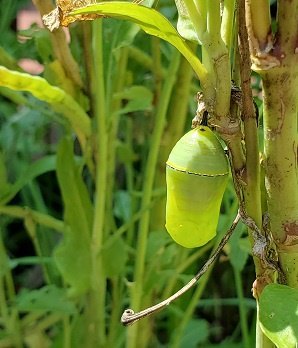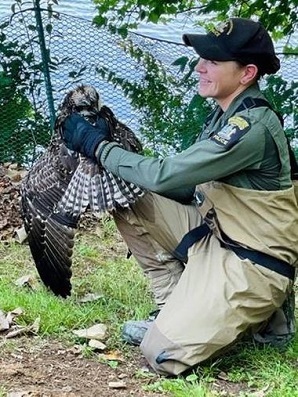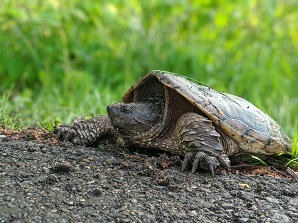Help Monarchs on their Long Migration South
 Monarch butterflies (Danaus plexippus) begin their annual fall migration in mid-August. These butterflies are the great-great-grandchildren of the monarchs that migrated to Mexico last fall. Monarch butterflies (Danaus plexippus) begin their annual fall migration in mid-August. These butterflies are the great-great-grandchildren of the monarchs that migrated to Mexico last fall.
You can help monarchs by providing food (nectar) and keeping those areas protected:
- Turn a portion of your lawn into a wildflower meadow—plant milkweed or other native wildflowers.
- Delay mowing areas with milkweed until later in the fall.
- Avoid using herbicides—they kill all life-stages of monarchs (egg, larva (caterpillar), pupa, and adult).
-
Report sightings of adults online. View a map of the sightings so far this year.
Check out a chart of when migration peaks in your area.
Chrysalis Stage
Have you seen a small green pod about an inch long (see photo above)? This is a monarch caterpillar once it enters the pupa stage and is now in a chrysalis. If you see one, try not to disturb it. They will find a safe place - often under a milkweed leaf - to enter this stage in their development, which lasts about 9-14 days. Sometimes they will pupate hanging under eaves, decks, or other garden plants, sometimes even on window screens!
Photo by Sandy Van Vranken.
Recent Environmental Conservation Officer Reports of Wildlife Rescues
 If at First You Don't Succeed, Try, Try Again - Sullivan County If at First You Don't Succeed, Try, Try Again - Sullivan County
On August 8, Environmental Conservation Officer (ECO) DuChene responded to an osprey in distress in the town of Fallsburg. Upon the officer's arrival, she was met by several concerned local residents to assist with locating the young osprey. Working together, the osprey was successfully captured for closer observation. Missy Runyan at the Friends of the Feathered and Furry Wildlife Center in the town of Hunter helped assess the extent of injuries and determined the fledgling was simply an unskilled flyer and took a tumble into the water. The bird was returned to the shoreline to reunite with its parents in a nearby nest. Thanks to ECO DuChene, the responding residents had the chance to get up close and personal with their very first osprey.
Playing Chicken - Putnam County
While on patrol on July 26, Environmental Conservation Officer ECO Crisafulli received a call for a hawk in distress at a residence in the village of Brewster. The ECO met with the homeowner and found the hawk stuck in a chicken coop where it was being attacked by some of the chickens. Officer Crisafulli safely rescued the red-shouldered hawk, which did not appear to sustain any apparent injuries. Following the incident, the ECO released the hawk and it flew away.
'Dangerous Turtle' - Suffolk County
On August 11, ECO DeRose responded to assist Suffolk County Police with a 911 call for a ‘dangerous turtle' in the garden of a residence. Upon arrival, ECO DeRose determined it was a large native snapping turtle with a shell almost 18 inches long. ECO DeRose, along with Suffolk County Police, safely removed the turtle and transported it to a licensed wildlife rehabilitator for evaluation. After it was determined to be in good health, they released the snapping turtle into a local pond.
 What to do if you encounter a snapping turtle: What to do if you encounter a snapping turtle:
Usually, you don't need to do anything! When they are on land, try to give them some extra space and they will move on. If you must move a snapping turtle, use caution; either pick her up at the rear of the shell near the tail using two hands or slide a car mat under the turtle to drag her a short distance. They try to avoid confrontation and are more likely to defend themselves on dry land. Snappers spend most of their lives in the water, where they will generally swim away from people when encountered and are usually docile.
Learn more about snapping turtles in the April 2017 Conservationist (PDF).
Top photo: ECO DuChene with fledgling osprey. Bottom photo: snapping turtle by Holly Faulkner.
Update on New Songbird Illness
In the spring and summer of 2021, the public reported many deaths in young songbirds—common grackles, American robins, blue jays, and other species—in the mid-Atlantic states. It was thought to be a new disease, or syndrome. Birds had swollen crusty eyes and/or an inability to hop or fly. Scientists at several regional laboratories have not been able to find a common disease agent or toxin that is the same for these bird deaths. They have ruled out many likely possibilities however, including: West Nile Virus, finch conjunctivitis, Avian Influenza, SARS-CoV-2 (virus that causes COVID-19 in humans), Newcastle Disease, various fungi, bacteria, parasites and viruses, and common toxins—including many pesticides.
So far, DEC has not documented any fledgling or adult birds in New York that fit the profile of this illness. We have received increased numbers of dead bird reports due to widespread media coverage, increased public awareness, and our own recommendations to report any suspicious bird deaths. Dead bird reports in the states where the illness was initially found have now decreased.
We will continue to monitor our bird populations for signs of the illness and to stay informed on the status in other nearby states. For updates on this bird illness please visit DEC’s animal diseases webpage or Cornell's Wildlife Health Lab webpage.
|



 If at First You Don't Succeed, Try, Try Again - Sullivan County
If at First You Don't Succeed, Try, Try Again - Sullivan County What to do if you encounter a snapping turtle:
What to do if you encounter a snapping turtle: